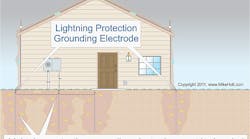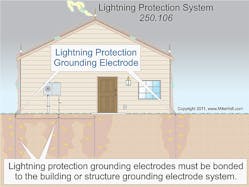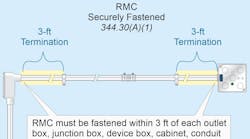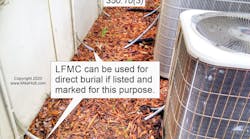All questions and answers are based on the 2011 NEC.
Q. What wiring methods does the NEC permit in a Class I, Div. 2 location?
A. Only the following wiring methods are permitted within a Class I, Div. 2 location [501.10(B)(1)]:
1) Wiring methods permitted in Class I, Div. 1 locations [501.10(A)].
2) Enclosed gasketed busways and enclosed gasketed wireways.
3) PLTC and Type PLTC-ER cable terminated with listed fittings in accordance with Art. 725.
4) ITC and ITC-ER cable terminated with listed fittings as permitted in 727.4.
5) Types MC, MV, or TC cables including installation in cable tray systems and terminated with listed fittings.
6) Where metallic conduit doesn’t provide sufficient corrosion resistance, reinforced thermosetting resin conduit and Schedule 80 PVC conduit can be used, but only in industrial establishments where maintenance and supervision ensure that only qualified persons service the installation.
If flexibility is necessary, these following wiring methods are permitted [501.10(B)(2)]:
1) Listed flexible metal fittings.
2) Flexible metal conduit with listed fittings.
3) Liquidtight flexible metal conduit with listed fittings.
4) Liquidtight flexible nonmetallic conduit with listed fittings.
5) Flexible cords listed for extra-hard usage, containing an equipment grounding conductor, and terminated with listed fittings.
Notes:
• See the definition of “Grounding Conductor, Equipment” in Art. 100.
• If flexible cords are used, they must comply with 501.140.
• See 501.30(B) for equipment grounding requirements where flexible conduit is used.
According to 501.10(B)(4), general-purpose enclosures and fittings are permitted in Class I, Division 2 locations unless the enclosure contains make-and-break contacts for meters, instruments, and relays [501.105(B)(1)], switches, circuit breakers, or motor controllers [501.115(B)(1)], signaling, alarm, remote-control, and communications systems [501.150(B)].
Q. What are the requirements for the grounding electrode system when a lightning protection system is installed on a building/structure?
A. If a lightning protection system is installed on a building/structure, then it must be bonded to the building/structure grounding electrode system [250.106] (Figure). The grounding electrode for a lightning protection system must not be used as the required grounding electrode system for the buildings or structures [250.60].
Informational Note 1: See NFPA 780 — Standard for the Installation of Lightning Protection Systems, which contains detailed information on grounding, bonding, and side-flash distance from lightning protection systems.
Informational Note 2: To minimize the likelihood of arcing between metal parts because of induced voltage, metal raceways, enclosures, and other metal parts of electrical equipment may require bonding or spacing from the lightning protection conductors in accordance with NFPA 780.




